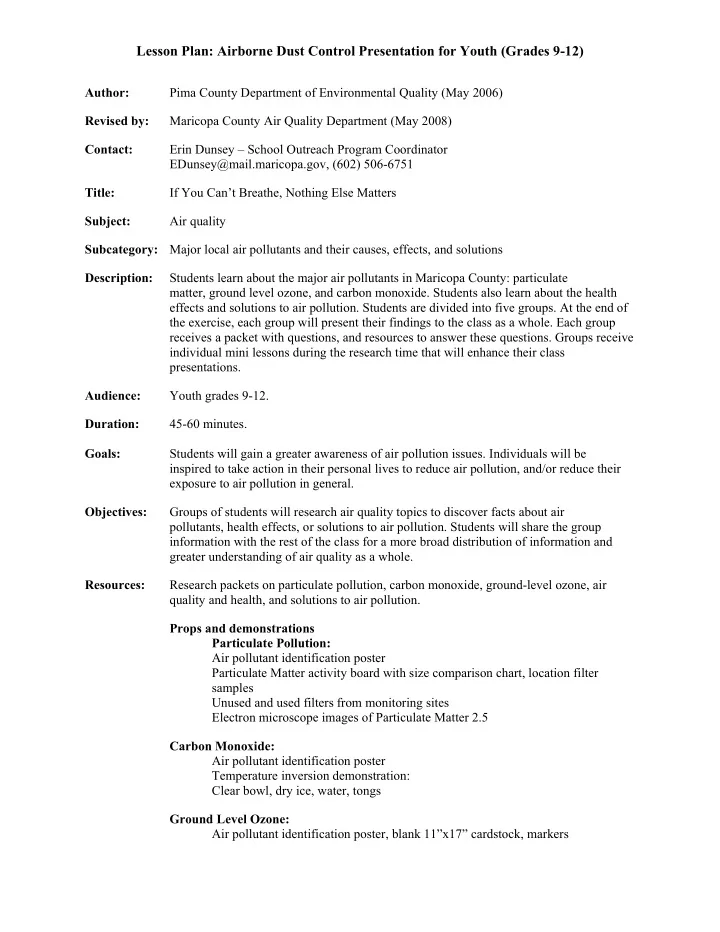

Lesson Plan: Airborne Dust Control Presentation for Youth (Grades 9-12) ! Author: Pima County Department of Environmental Quality (May 2006) Revised by: Maricopa County Air Quality Department (May 2008) Contact: Erin Dunsey – School Outreach Program Coordinator EDunsey@mail.maricopa.gov, (602) 506-6751 Title: If You Can’t Breathe, Nothing Else Matters Subject: Air quality Subcategory: Major local air pollutants and their causes, effects, and solutions Description: Students learn about the major air pollutants in Maricopa County: particulate matter, ground level ozone, and carbon monoxide. Students also learn about the health effects and solutions to air pollution. Students are divided into five groups. At the end of the exercise, each group will present their findings to the class as a whole. Each group receives a packet with questions, and resources to answer these questions. Groups receive individual mini lessons during the research time that will enhance their class presentations. Audience: Youth grades 9-12. Duration: 45-60 minutes. Goals: Students will gain a greater awareness of air pollution issues. Individuals will be inspired to take action in their personal lives to reduce air pollution, and/or reduce their exposure to air pollution in general. Objectives: Groups of students will research air quality topics to discover facts about air pollutants, health effects, or solutions to air pollution. Students will share the group information with the rest of the class for a more broad distribution of information and greater understanding of air quality as a whole. Resources: Research packets on particulate pollution, carbon monoxide, ground-level ozone, air quality and health, and solutions to air pollution. Props and demonstrations Particulate Pollution: Air pollutant identification poster Particulate Matter activity board with size comparison chart, location filter samples Unused and used filters from monitoring sites Electron microscope images of Particulate Matter 2.5 Carbon Monoxide: Air pollutant identification poster Temperature inversion demonstration: Clear bowl, dry ice, water, tongs Ground Level Ozone: Air pollutant identification poster, blank 11”x17” cardstock, markers
Lesson Plan: Airborne Dust Control Presentation for Youth (Grades 9-12) ! Air Quality and Health: Health effects identification poster, healthy/unhealthy pigs lungs comparison kit Solutions to Air Pollution: Solutions identification poster, airville board, pictures or examples of actions that pollute less Reference Materials: AQDX Fugitive Dust Program outreach and education staff Literature: Airborne Dust and Your Health Air Quality and Your Health Criteria pollutants chart Ozone 26 Ways to Healthy Air 7 Ways You Can Be Air Smart Car Care for Clean Air Activity Plan: Introduction • With the aid of PowerPoint (or not) open discussion on the environment and air. Break class into five (or four if not enough students) groups for group research projects. Hand each group a packet with appropriate demonstration supplies and/or props. Instruct them to research the resources in the packet to answer questions provided. Have them be ready to present this information to the class. Facilitate Group Activity • Visit the Particulate Matter group. Discuss issues of concern, give a mini-lesson on the PM filters (what they are, where they are from, why they are discolored to varying degrees), PM activity board (for PM size-comparison chart, filter samples, location of monitoring sites), and PM electron microscope image. Encourage group to use these props during their class presentation. Assist with presentation if more points need to be made or clarified. • Visit the Carbon Monoxide group. Discuss issues of concern. Give a mini-lesson on temperature inversions. Perform the dry ice experiment to illustrate how pollutants can be trapped in cold air under a layer of warm air in the Maricopa County. • Encourage group to use this demonstration during their class presentation. Assist with presentation if more points need to be made or clarified. • Visit the Ground Level Ozone (Smog) group. Discuss issues of concern, ensuring they understand how ozone is created at ground level. Have at least one person in the group draw a picture of a vehicle, pointing out the parts of the vehicle that emit precursor pollutants to ozone. Have them draw a sun as another precursor ingredient. Encourage the group to use this drawing during their class presentation. • Assist with presentation if more points need to be made or clarified. • Visit the Air Quality and Health group. Discuss issues of concern. Perform a demonstration using the healthy and unhealthy lung kit to illustrate the difference between breathing clean air versus dirty air. Encourage group to use this demonstration during their class presentation. Assist with presentation if more points need to be made or clarified. • Visit the Solutions to Pollution group. Discuss issues of concern. Review Airville board and actions people take or activities people engage in that affect air quality. • Have them point out several actions that will reduce the levels of each pollutant.
Lesson Plan: Airborne Dust Control Presentation for Youth (Grades 9-12) ! • Review pictures or examples of solutions to air pollution. Encourage them to use these prop during their class presentation, and if time, have class members approach Airville to play. Assist with presentation if more points need to be made or clarified. Facilitate group discussion • Throughout and after the class presentations, answer questions students ask about air quality issues. Method of Learning: Small group discussion, large group discussion, demonstration, lecture. Assessment: Written evaluation by teacher assessing presenter, visual aids, and measure learning of students. !
Recommend
More recommend